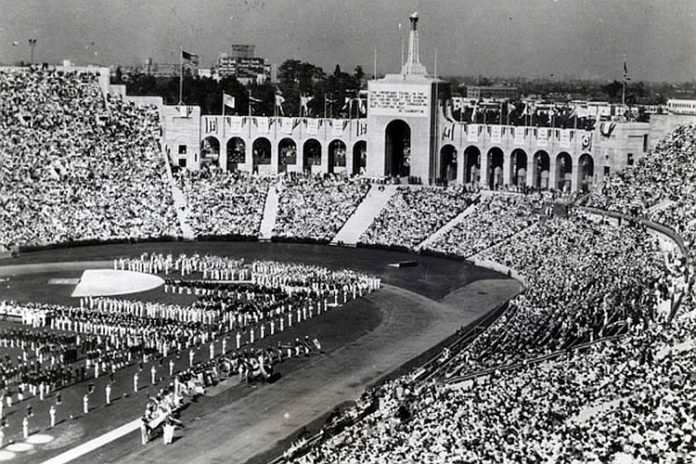
★ The Sports Examiner: Chronicling the key competitive, economic and political forces shaping elite sport and the Olympic Movement.★
★ Two more! Our 27th and 28th donors now have 65% of our summer fund-raising goal covered. Come on, join in! ★
★ To get The Sports Examiner by e-mail: sign up here! ★
≡ THE 5-RING CIRCUS ≡
1. Scoreless tie with Portugal advances U.S. at World Cup
2. Australia, Japan make major Women’s World Cup statements
3. Australia won most golds, U.S. top swim team at Worlds
4. IOC discards OCA elections, will work with Singh
5. Remembering the pivotal Los Angeles 1932 Olympic Games
At the FIFA Women’s World Cup, the U.S. played to a surprising scoreless tie with Portugal, which was good enough to advance to the knock-out round as the second-place team in Group E. The Netherlands crushed Vietnam, 7-0, to win the group on Tuesday. In Monday’s games, Australia won Group B and sent Olympic champs Canada home with a 4-0 shutout, and Japan crushed Spain with its counter-attacks, also by 4-0 to win Group C. Japan, especially, made a statement against one of the tournament favorites. Australia had a dreamy World Aquatics Championships in the pool, winning 13 golds, but the U.S. was clearly the top team according to our eight-place scoring table; under-appreciated, but also enormously impressive: China, which won its second-most-medals ever at a Worlds. The International Olympic Committee told the Olympic Council of Asia that its July elections were irrelevant and it will work with the organization’s former interim head, Randir Singh of India. This cuts off any policies which the elected head, Kuwait’s Sheikh Talal, might implement at an extraordinary assembly he called for 15 August. It was 91 years ago that Los Angeles pulled off its first Olympic miracle, staging the Games of the Xth Olympiad in the depths of the Great Depression. The event was not only an aesthetic success, introducing the all-teams Olympic Village concept, the 16-day schedule followed ever since and the use of a podium, with raised flags and anthems for award ceremonies, but also had the first-ever post-Games surplus of $1.25 million, paying back the original State of California bond that financed the organizing committee!
● Panorama: Ukraine (more from Sabre star Olha Kharlan on her disqualification) = Athletics (Asinga completes 100/200 double at SoAm Champs) = Shooting (possible European lead ammo ban?) = Skating (FIFA’s Smith to replace Schmid as ISU Secretary General) = Water Polo (Perrone and Musselman named 2022 players of the year) ●
● Errata: Some readers saw a version of yesterday’s post which placed the World Triathlon Series races in “Sutherland” instead of Sunderland, Great Britain. Nope; Sutherland is in Scotland and Sunderlund is in England; now corrected. ●
1.
Scoreless tie with Portugal advances U.S. at World Cup
The U.S. Women’s National Team had a clear assignment against Portugal in its final Group E game in Auckland (NZL) at the 2023 FIFA Women’s World Cup: draw or win and move on to the knock-out round.
The U.S. was all on offense from the opening kick, but the Portuguese held steady with five players on the back line and a clever attacking style that emphasized speed on the wings, especially from strikers Diana Silva and Jessica Silva.
U.S. star striker Alex Morgan couldn’t convert from a tight angle in the third minute and American forward Lynn Williams, seeing her first World Cup action, had a chance to score with a header of a Sophia Smith pass in the middle of the box in the 14th, but Portuguese keeper Ines Pereira made the save. Portugal’s Jessica Silva than missed a shot on the other end two minutes later, missing to the left of the goal.
Portugal controlled large segments of the game with good movement in the U.S. end and careful passing, but not many shots. Williams had another close-in chance at 45+2, but her drive was caught by Pereira. The half ended with Portugal surprising with 54% possession, but with the U.S. taking seven shots to three.
The second half was more of the same, but U.S. midfielder Lindsey Horan stole a pass in the 54th and sent a lead pass to Morgan, who dribbled in, swerved around Pereira, but her shot was blocked from a tight angle at the right side of goal. The U.S. had control of this portion of the game, but could not score, in part due to tight defense, in part just missed finishes.
Past the hour mark, the U.S. started pressing Portugal in front of midfield, looking for turnovers. But the mistakes did not come. A run with the ball by Morgan in the 85th looked promising, but her first shot was blocked and the second off a rebound was saved by Pereira. Another Morgan drive at 90+1 was wide.
Then Portugal had its best look at the game, as substitute striker Ana Capeta took a flick-on and dribbled free for a shot ahead of the U.S. defenders from the right side of the goal at 90+2 and sent a right-footed drive under U.S. keeper Alyssa Naeher, but it hit the right goalpost and spun away harmlessly.
Portugal controlled possession at 56%, and although the U.S. had a 17-6 shots advantage, Capeta almost got the Portuguese through and eliminated the top-ranked Americans. But the U.S. moves on as second in the group and will play in Melbourne on Sunday.
¶
Concurrent with the U.S. and Portugal was the Netherlands and Vietnam in Dunedin, with the Dutch taking charge quickly and turn the game into a rout. Striker Lieke Martens chipped in a shot in the eighth minute, fellow striker Katja Snoeijs scored on a left-footed strike in the 11th, midfielder Esmee Brugts sent a rainbow into the net in the 18th and so on.
Midfielder Jill Roord scored in the 23rd and midfielder Danielle van der Donk in the 45th for a 5-0 halftime lead, with the Dutch holding 73% of possession and 24 shots to four for Vietnam.
Brugts scored again in the 57th (6-0), and Roord got her second in the 83rd for the 7-0 final. The Dutch finished with 72% of possession and a 42-5 shots advantage.
With the U.S. draw, the Netherlands won the group at 2-0-1 (W-L-T) with seven points and a +8 goal differential. The U.S. finished 1-0-2 (five points; +3) for second, with Portugal third (1-1-1) and Vietnam fourth (0-3).
2.
Australia, Japan make major Women’s World Cup statements
Two stunning results on Monday elevated both Australia and Japan’s status at the 2023 FIFA Women’s World Cup in Australia and New Zealand, with 4-0 wins that eliminated Olympic champ Canada and relegated Spain to second place in Group C. Japan, especially, is now one of the teams to watch, having won its games by 5-0, 2-0 and 4-0 against Zambia, Costa Rica and the Spanish.
● Group B: Australia 4, Canada 0 ● This was essentially win or go home for Australia, while Canada needed at least a draw to move on, but the outcome in Melbourne was not close. Midfielder Hayley Raso got a goal in the ninth minute to put the Matildas up, 1-0, on a right-to-left strike from 15 yards out off a loose ball that sailed past three defenders. Raso struck again in the 39th, again off a loose ball right in front of the goal on a corner kick that Raso clubbed into the net.
The half ended 2-0, with Canada taking most of the possession, but Australia finding the net. In the 58th, an endline cross by midfielder Caitlin Foord found striker Mary Fowler open in front of the net and her left-footed swing bounced the ball past Canadian keeper Kailen Sheridan, off the right post and in. Game over.
A penalty was called on Canadian defender Jessie Fleming in stoppage time and defender Steph Catley scored for the 4-0 final at 90+4. Canada’s 61% possession didn’t help, and neither did their 11 shots to 10 for the winners. With the win, the Matildas (2-1) won the group and move on.
● Group B: Ireland 0, Nigeria 0 ● With Australia crushing Canada, all Nigeria needed to move on was a draw and that’s what they got against the Irish, in Brisbane. But there were chances.
Irish defender Katie McCabe missed a chance in the fifth minute, sending a promising shot wide, and Nigerian striker Asisat Oshoala sent a tight-angle shot wide in the 14th off a fast break following a turnover.
In the 55th, a long cross into the box found midfielder Uchenna Kanu for a strong head, but Irish keeper Courtney Brosnan barely deflected it and it went off of the crossbar and was cleared away from goal.
Ireland had 60% possession, but Nigeria was the aggressor with 11 shots to five, and is moving on.
● Group C: Japan 4, Spain 0 ● No one saw this coming, after Spain won its first two games by 8-0. And in Wellington, the Spanish employed their usual possession-oriented attack and ended with 77% to 23% for Japan and had 10 shots to seven. And they got crushed.
A left-footed lead pass from midfielder Jun Endo just inside the Spanish half found forward Hinata Miyazawa in the 12th and she outraced the defenders for a left-footed strike that eluded keeper Misa Rodriguez for a 1-0 lead. In the 29th, Miyazawa was leading a fast break with striker Riko Ueki and sent a cross which Ueki lined up and then sent a shot that was blocked by defender Irene Paredes, but had enough force to pop up and sail over Rodriguez’s hand and made it 2-0.
Ueki was leading another counter in the 40th – four on six – and sent a through-ball to Miyazawa on the right side and she finished with another strike over Rodriguez’s hand and into the net for a 3-0 lead in the 40th. That was the score at half.
Substitute striker Mina Tanaka took a ball at the sidelines and dribbled into the box and scored in the 82nd with a left-footed shot from the center of the box that popped into the left corner of the goal.
Japan has outscored its opponents 11-0 and is a dangerous team, able to play with possession, as they it demonstrated, without it as well.
● Group C: Zambia 3, Costa Rica 1 ● Both teams had been eliminated, but Zambia for its first Women’s World Cup win in Hamilton, scoring right away as defender Lushomo Mweemba volleyed in a corner from the right side in the third minute for Zambia’s first goal in the tournament!
Striker Barbra Banda was fouled on the box in the 29th and converted the penalty for a 2-0 lead at the half, with the 1,000th goal in the history of the Women’s World Cup.
Costa Rica got one back – its first of the tournament – in the 47th, as a corner was headed at the mouth of goal and bounced off of midfielder Melissa Herrera for the score. But Zambia got a final score from midfielder Racheal Kundananji, who finished off a pass from Banda, standing alone at the left of goal at 90+3.
The Costa Ricans had 57% of possession and a 16-15 edge on shots, but both teams are going home at least having scored a goal, and Zambia with its first win.
¶
Some observations can be made now, with the group stage through two games for all 32 teams. One way to measure relative standing around the world is to see how teams in each geographic region did in intersectional matches, with statistics compiled by TheSportsExaminer.com:
Africa: 4 teams
● 2-4-2 (W-L-T)
● Goals: 7-22
● Shots: 71-151
● Possess.: 34% on average
Asia: 5 teams
● 4-6-0
● Goals: 9-11
● Shots: 99-143
● Possess.: 44% on average
Europe: 12 teams
● 10-4-2
● Goals: 28-9
● Shots: 279-142
● Possess.: 63% on average
(4 Europe vs. Europe games not included)
North & Central America, Caribbean: 6 teams
● 2-5-3
● Goals: 6-13
● Shots: 112-175
● Possess.: 43% on average
(1 intra-CONCACAF match not included)
Oceania: 2 teams
● 2-2-0
● Goals: 4-4
● Shots: 69-37
● Possess.: 62% on average
South America: 3 teams
● 3-2-1
● Goals: 11-6
● Shots: 87-69
● Possess.: 53% on average
Japan showed against Spain in the third game for both (so not included above) that possession does not equal winning, but once again European and South American teams are the ones with a positive goal differential through the first two rounds, as they were at the FIFA World Cup in Qatar last year.
At the 2019 FIFA Women’s World Cup, European teams were 7-1 in the round-of-16 and produced seven of eight quarterfinalists and three of the four semifinalists. Will they do it again?
As far as the first-time entries in the Women’s World Cup, only Morocco (1-1), Haiti (0-2) and Portugal (1-1) remain in at least mathematical contention for play-off berths. Already eliminated are the Philippines, Vietnam, Zambia, Panama and Ireland.
3.
Australia won most golds, U.S. top swim team at Worlds
One of the many side stories to the swimming competition at the just-completed World Aquatics Championships in Fukuoka (JPN) was the dust-up over the medal standings shown on the NBC-Peacock telecasts, initially ranking the teams by the number of gold medals, then switching on day 6 to show rankings by total medals instead, which put the U.S. on top.
SwimSwam.com noted it and the Sydney Morning Herald asked famed American coach Bob Bowman and Australian head coach Rohan Taylor their opinions. Here’s our opinion:
● American media have consistently shown total medal standings as a reflection of total team strength, going back to the Cold War days when the USSR competed with the expressed desire to win the most medals.
● Overall team strength measured by gold medals is useless and so are medals. A deeper dive is needed, one which TheSportsExaminer.com has compiled for the 2016 and 2020 Olympic Games and plans to do for Paris 2024. That’s for scoring places 1-8 – the finalists – with a system long used in NCAA track & field competition, with 10-8-6-4-3-2-1 points. This gives extra weight to finishing first and second, but takes in placements into a final. You had to beat people to score points.
So, what happened in Fukuoka? The Australians were superb at the top end, but were not the best team, in scoring or placements:
1. 379.83 points: United States (64 top-8 placements)
2. 270.33 points: Australia (41)
3. 167.33 points: China (30)
4. 108.00 points: Great Britain (21)
5. 99.50 points: Canada (20)
6. 87.00 points: France (18)
7. 80.00 points: Italy (16)
8. 47.00 points: Japan (18)
9. 46.00 points: Netherlands (12)
10. 40.00 points: Germany (14)
11. 37.00 points: Sweden (8)
12. 28.00 points: Tunisia (3)
13. 25.00 points: Hungary (8)
14. tie, 23.00 points: South Africa (3)
14. tie, 23.00 points: Lithuania (3)
Some 38 countries scored points, vs. 21 that won medals. Australia was great, but the U.S. effort was impressive. And China has surged, with 16 medals (5-3-8), its second-biggest output ever. Only in 1994 – when it won 19 medals (12-6-1) and outswam the U.S. in golds (21: 4-10-7) – had the Chinese ever won more. They also won 14 in the 2011 Worlds, 13 in 2015 and 10 in 2017.
Keep the Chinese ascendance in mind for Paris in 2024. A deeper focus on what happened to the U.S. – good and not-so-good – tomorrow.
¶
Katie Ledecky was named as the World Aquatics Female Swimmer of the Year for 2022 during the 2023 Worlds in Fukuoka. It’s her second win, also having been named way back in 2013!
In Fukuoka, she became the first swimmer ever to win the same event six times in taking the women’s 800 m Freestyle.
4.
IOC discards OCA elections, will work with Singh
The International Olympic Committee is telling the Olympic Council of Asia again that its 8 July election in Bangkok (THA) of Kuwait’s Sheikh Talal Fahad Al-Ahmad Al-Sabah as President is null and void.
Reuters reported Sunday that a letter was sent to India’s Randhir Singh, who had been acting as interim OCA President until elections could be held, including:
“Seeing as the IOC investigation is likely not to be concluded before October 2023 and since the IOC has not recognised the election of Sheikh Talal Al-Sabah, the IOC will continue to work with you [Singh] as OCA’s acting President. …
“Following the outcome of the IOC investigation, we will work with you to implement the next steps of a roadmap to ensure the continued functioning of the OCA according to the basic principles of good governance.”
Last Thursday, the IOC suspended for three years its already self-suspended member, and former OCA President, Sheikh Ahmad Al-Fahad Al-Sabah for interfering – against the IOC’s direct instructions – in the OCA elections by going to Bangkok for the OCA election to support his younger brother. The IOC Ethics Commission recommendations noted:
● “The Olympic Council of Asia is a continental association of NOCs recognised by the IOC; thus, the elections have to be recognised by the IOC.”
● “Considering the evidence gathered by the IOC and the impact on the OCA’s elections of Sheikh Ahmad Al-Sabah’s behaviour, it appears from the exchange of emails between the OCA’s Ethics Committee and the IOC [Chief Ethics Officer] that there is a need for a full assessment of the potential non-respect of the OCA’s elections process.”
The rush to de-legitimize Sheikh Talal’s election comes as he called for an Extraordinary General Assembly of the OCA on 15 August, but without providing details of the purpose of such a meeting. The IOC’s action makes that event – in their eyes – irrelevant.
This is a rarely-seen, harsh intervention by the IOC in the operation of a continental association of National Olympic Committees, but one involving power players and very little trust on the IOC’s side about what Sheikh Talal might be planning. Although not of heavy interest to the public, the developments in this situation will be closely watched within the Olympic Movement.
5.
Remembering the pivotal Los Angeles 1932 Olympic Games
As Friday, 28 July was the 39th anniversary of the revolutionary Games of the XXIIIrd Olympiad in Los Angeles, Sunday was the 91st anniversary of the equally-important Games of the Xth Olympiad, also in Los Angeles, in 1932.
While the U.S. sports movement had been a key collaborator with France’s Pierre de Coubertin in the revival of the Olympic Games in Athens in 1896, the first Games held in the U.S. – in St. Louis in 1904 – was widely considered a disaster, lumped in with the Louisiana Purchase Exposition, better known as the 1904 World’s Fair.
Los Angeles changed all that. Like so many Olympic bids, the concept was developed by a civic group – the California Fiestas Association – as a way to promote Los Angeles nationally and internationally, just as “Hollywood” was beginning to become synonymous with the motion picture industry.
Prominent developer William May “Billy” Garland made a trip to the 1920 Antwerp Olympic Games and met with the IOC, asking for the 1924 Games. But Paris and Amsterdam were already in line for 1924 and 1928; nevertheless, the IOC elected Garland as a member from the U.S.
And, low and behold, Los Angeles was awarded the Games in 1923, the same year in which the Los Angeles Memorial Coliseum was opened as the city’s monument to its World War I servicemen. The heavy-duty organizing didn’t get started until 1929, after the California Olympiad Bond Act of 1927 was confirmed by 73-27% in November 1928 to provide $1 million in funding for the organizing of the Games.
Then the Depression hit, but Los Angeles plowed ahead. Despite massive doubts on the local, national and international levels, a staff of 70 finally put the event together with enormous local support, but no additional government funding.
And on 30 July 1932, U.S. Vice President Charles Curtis opened the Games before 101,022 at the Coliseum. Given the distances and the Depression, only 1,503 athletes were entered and 1,427 participated from 37 countries, in 14 sports and 117 events, per the Official Report of the Games.
The 1932 Games impacted the future of the Olympic Movement in significant ways:
● First Games contained within 16 days; prior Games had been spread over many weeks or months.
● First all-nations Olympic Village, built on a temporary basis on 250 acres in Baldwin Park; this was for men only; the 126 women athletes were accommodated at the Chapman Park Hotel.
● First awards podium, with the raising of flags and playing of anthems, requested in 1931 by IOC President Henri de Baillet-Latour (BEL).
● First appearance of automatic timing and photo-finish technology, by former American Olympic Association President Gustavus T. Kirby, working with Western Electric.
● First organizing committee to realize a post-Games surplus, after repaying the $1 million bond which initially financed it!
The Xth Olympiade Committee reported a surplus of $1.25 million after expenses, and then won a court fight to repay $1,053,733 in California bond money (with interest) voted in 1928. The final surplus was approximately $196,267 in 1933 – in the depths of the Great Depression – and given to the city and county.
The individual star of the Games had to be the wiry Texan, Mildred “Babe” Didriksen of the U.S., 21, who won the women’s 80 m hurdles and javelin – both new events – and was second in the high jump in a jump-off.
A permanent memorial to the Games, not well known by many Angelenos today was the renaming of the important east-west artery Tenth Street as Olympic Boulevard in honor of the Xth Olympiad.
The 1932 Games was so successful that Garland was asked in 1939 to form a group to take over the 1940 Olympic Games, given to Tokyo, which was deeply involved in an invasion of China. The result was the Southern California Committee for the Olympic Games, which finally brought the Games back to Los Angeles for the Games of the XXIIIrd Olympiad in 1984.
≡ PANORAMA ≡
● Ukraine ● More from four-time World Sabre Champion Olha Kharlan, who was disqualified by the International Fencing Federation (FIE) for not shaking hands with Russian Anna Smirnova, whom she defeated, 15-7, in the round-of-32 at the World Championships in Milan (ITA), and then had the suspension lifted by the FIE under pressure from the IOC.
The Ukrainian news site Tribuna caught up with her prior to her reinstatement; the interview included:
● “I behaved professionally, I won this fight honestly. But I told her that I would not shake her hand. That’s it. I said: ‘I will not shake your hand.’”
● “As far as I know, the [Russian] fencing federation has filed a complaint and protest to keep the neutral status of this athlete. In my opinion, we need to remind international federations that the process of recognizing neutrality should be very serious and not the same as it was before. They should approach this very carefully or simply not accept these athletes for competitions at all.”
● “This is a 100% precedent that happened to me, to my federation and our country, to the athletes. Now, if I were our national federations, especially in contact sports, I would put more pressure on international federations that allow ‘neutral’ athletes like this athlete. And she is not the only one.
“They need to put pressure on. And with the example of tennis, the example of fencing, it is possible. So change this rule so that there are no cases like the one with fencing. Because it has to change, and Ukrainian athletes will not shake hands with Russian and Belarusian athletes – this is a fact. So, as I said, the rules have to change, because the world is changing.”
Asked about Smirnova’s theatrics, including standing and then sitting on the piste in a chair for more than 45 minutes:
“I said it before. I said it in interviews, including with Tribuna, that I would not shake hands. There was no question of shaking hands. So I think they saw that and wanted to provoke me. They wanted to do it because the rules say that everyone has to shake hands. But they were changing somehow, and no one canceled the Covid rules until the last moment. Therefore, I think they were ready for it, the attitude was such that it was a direct provocation on their part.”
Kharlan was finally allowed to fence in the Team Sabre competition and her Ukrainian team finished fourth.
● Athletics ● Suriname’s Issam Asinga added the men’s 200m title to go along with his record-setting 100 m win at the South American Championships in Sao Paolo (BRA).
Asinga, 18, who has signed a letter of intent with Texas A&M, won the 200 m in 20.19 (+0.7 m/s) on Sunday, after taking the 100 m in a World U-20 Record of 9.89 on Friday.
● Shooting ● An interesting development in Europe, where the European Chemicals Agency (ECHA) is working to ban ammunition with lead in it, as is used by competitive shooters.
The International Shooting Sport Federation (ISSF) posted a warning notice on Friday:
“The movement to ban lead shot or severely restrict the use of lead ammunition at shotgun ranges and outdoor rifle/pistol ranges in Europe is at a critical state. ISSF has met with EU Commission officials and tried to offer better solutions. Soon the European countries will vote on this controversial issue. Now we need our European members to contact their political leaders and European Commission members to further ensure that this European Chemical Agency proposal, in its current state, does not get approved.
“The ISSF is in support of managing lead in a responsible way, and we will continue to research best practices and feasible alternatives, we feel that the ECHA proposal will create great economic hardship to many local ranges and irreversibly damage our sport at local and regional levels.”
The federation’s detailed submittal took direct aim at the ECHA’s rationale that the use of lead ammo is ingested by local wildlife and therefore a hazard:
“In the sports shooting portion (shooting ranges) of the restriction proposal, ECHA’s knowledge on all various shooting disciplines and their specific features and demands is inadequate. They inappropriately assess the risk by ignoring the complexity in the proportionality of these ranges and ignore the socioeconomic impacts and with broad strokes propose a simple solution that creates great difficulties, costs and impracticalities for many EU countries. …
“ECHA demonstrates they do not understand target shooting sports and they make errors in assumptions because they do not take into consideration the variability of volume, uses, and sports practised at the shooting ranges. The actual risks that the majority of shooting ranges pose to the environment are minimal and many have already taken precautions recommended or required by their nation.”
● Skating ● The International Skating Union announced Colin Smith (GBR) as its next Secretary General, replacing the highly-respected Fredi Schmid (SUI) at the end of 2023.
Schmid has been the administrative head of the ISU since 1996 and has garnered wide praise for credibility, efficiency and clarity, qualities which are too rare in senior International Federation officers. Smith comes to the ISU from FIFA, where he was the Chief Tournaments & Events Officer and Chief Operating Officer of the FIFA World Cup from 2015-2023.
Smith will begin at the ISU in October to ensure a smooth transition.
● Water Polo ● World Aquatics named Spain’s Felipe Perrone and American Maddie Musselman as the 2022 Athletes of the Year following the World Aquatics Championships in Fukuoka (JPN).
Musselman was a key star for the American women as they won a fourth straight Worlds gold in Budapest last year, scoring 20 goals during the tournament and named Most Valuable. Perrone, now 38, scored three times in the gold-medal shoot-out final with Italy, won by the Spanish, 15-14. It was his 11th Worlds appearance, going all the way back to 2001!
Both received a $10,000 bonus, a trophy and a specially-made “Athlete of the Year” robe from World Aquatics.
● Weightlifting ● The International Weightlifting Federation, still smarting from an incident at the European Championships in Yerevan (ARM), where an Azerbaijan flag was grabbed and set on fire during the opening ceremony in April and possible other situations with “neutral” athletes, has changed its rules for ceremonies. Now:
“The medal winners line up behind the podium, wearing the uniform clothing issued/approved by the Member Federations. It is forbidden for the medal winners to take on stage any flags or other items on stage during the medal ceremony.”
The flag-burning incident in Yerevan led to the Azerbaijani team leaving the championships; the two countries are in a decades-long conflict over Nagorno-Karabakh, which is part of Azerbaijan but has a mostly Armenian population.
Video review is also now required at all Olympic qualifying and championship events.
¶
You can receive our exclusive TSX Report by e-mail by clicking here. You can also refer a friend by clicking here, and can donate here to keep this site going.
For our updated, 787-event International Sports Calendar (no. 3) for 2023 and beyond, by date and by sport, click here!















